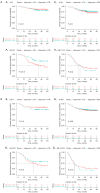Efficacy and safety of esophagectomy via left thoracic approach versus via right thoracic approach for middle and lower thoracic esophageal cancer: a multicenter randomized clinical trial (NST1501)
- PMID: 36111056
- PMCID: PMC9469177
- DOI: 10.21037/atm-22-3810
Efficacy and safety of esophagectomy via left thoracic approach versus via right thoracic approach for middle and lower thoracic esophageal cancer: a multicenter randomized clinical trial (NST1501)
Abstract
Background: Left thoracic approach (LTA) has been a favorable selection in surgical treatment for esophageal cancer (EC) patients in China before minimally invasive esophagectomy (MIE) is popular. This study aimed to demonstrate whether right thoracic approach (RTA) is superior to LTA in the surgical treatment of middle and lower thoracic esophageal squamous cell carcinoma (TESCC).
Methods: Superiority clinical trial design was used for this multicenter randomized controlled two-parallel group study. Between April 2015 and December 2018, cT1b-3N0-1M0 TESCC patients from 14 centers were recruited and randomized by a central stratified block randomization program into LTA or RTA groups. All enrolled patients were followed up every three months after surgery. The software SPSS 20.0 and R 3.6.2. were used for statistical analysis. Efficacy and safety outcomes, 3-year overall survival (OS) and disease-free survival (DFS) were calculated and compared using the Kaplan-Meier method and the log-rank test.
Results: A total of 861 patients without suspected upper mediastinal lymph nodes (umLN) were finally enrolled in the study after 95 ineligible patients were excluded. 833 cases (98.7%) were successfully followed up until June 1, 2020. Esophagectomies were performed via LTA in 453 cases, and via RTA in 408 cases. Compared with the LTA group, the RTA group required longer operating time (274.48±78.92 vs. 205.34±51.47 min, P<0.001); had more complications (33.8% vs. 26.3% P=0.016); harvested more lymph nodes (LNs) (23.61±10.09 vs. 21.92±10.26, P=0.015); achieved a significantly improved OS in stage IIIa patients (67.8% vs. 51.8%, P=0.022). The 3-year OS and DFS were 68.7% and 64.3% in LTA arm versus 71.3% and 63.7% in RTA arm (P=0.20; P=0.96).
Conclusions: Esophagectomies via both LTA and RTA can achieve similar outcomes in middle or lower TESCC patients without suspected umLN. RTA is superior to LTA and recommended for the surgical treatment of more advanced stage TESCC due to more complete lymphadenectomy.
Trial registration: ClinicalTrials.gov NCT02448979.
Keywords: Esophageal cancer (EC); esophagectomy; left thoracic approach (LTA); outcomes; right thoracic approach (RTA).
2022 Annals of Translational Medicine. All rights reserved.
Conflict of interest statement
Conflicts of Interest: All authors have completed the ICMJE uniform disclosure form (available at https://atm.amegroups.com/article/view/10.21037/atm-22-3810/coif). YSM, SGG, YL, ALH, JFL, XFL, THR, JHF, JQM, MQX, RQZ, GMX, XNF, KNC, WMM, YYL, HXL, ZRZ, YF, DHF, XDW, LGY, SM, WQW, YBG, JH report that this work was supported by the grants from National Science and Technology Support Program (Study ID Number: NKTRDP-2015BAI12B08-01, YSM). The other authors have no conflicts of interest to declare.
Figures



References
-
- Wu YK, Loucks HH. Surgical treatment of carcinoma of the esophagus. Chin Med J, 1941, 60:1-33.
-
- Shao LF, Chen YH, Cao ZR, et al. Surgical treatment of carcinoma of esophagus and gastric cardia-A 34-year investigation. The Chinese-German Journal of Clinical Oncology 2002;1:61-4. 10.1007/BF02851734 - DOI
Associated data
LinkOut - more resources
Full Text Sources
Medical
Miscellaneous
